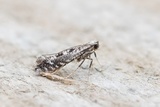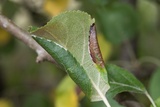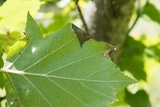Parornix scoticella (Stainton, 1850) Species
Last modified: Nov. 25, 2024, 12:44 p.m.
A rare species in Belgium.
Details
- Classification
- Family: Gracillariidae > Subfamily: Gracillariinae > Tribus: Parornichini > Genus: Parornix > Species: Parornix scoticella
- Vernacular names
- Appelzebramot (NL), Rowan slender (EN)
- First mention in Belgium
- Fologne E. 1862c. Notes sur quelques lépidoptères observés en Belgique. — Annales de la Société entomologique belge 6: 170–176. On page 174. view page
- Status
-
Native
Distribution
Imago
Forewing greyish with a row of tiny, whitish, inconspicuous striae along the costa; some dark brown spots near the inner margin. They resemble other species of Parornix but do show distinctive white palps and frons.
Without the knowledge of the larval hostplant, Parornix species are very difficult to identify; their genitalia should be studied.
Caterpillar
Greyish yellow, light brownish intestine tract visible; prothoracic segment with four blackish spots, the inner two larger than the two outer two.
Mine
The first instar makes a narrow, short gallery on the underside of the leaf. Following instars also consume the parenchyma thus turning the mine into a blotch which later turns brownish.
See also gracillariidae.net and bladmineerders.be.
Bionomics
The free-living instars spin a leaf margin or tip downwards into a flat fold or a cone-like fold and consume the parenchyma with that fold which turns greyish-brown to brown. In rarer cases, they construct a spinning in the center of the leaf at the underside.
They pupate within the fold and hibernate in the leaf among leaf litter on the ground.
The adults rest between foliage during the daytime but become active towards dusk and at night. They come to light.
Flight periods
The adults fly in two generations a year during May and June and again in July–August.
Observed on
- Host plant (species):
- Sorbus aucuparia and Sorbus aria
- Host plant (genera):
- Malus
The larvae feed mainly on Sorbus aucuparia and occasionally on Cotoneaster, Malus and other species of Sorbus.



